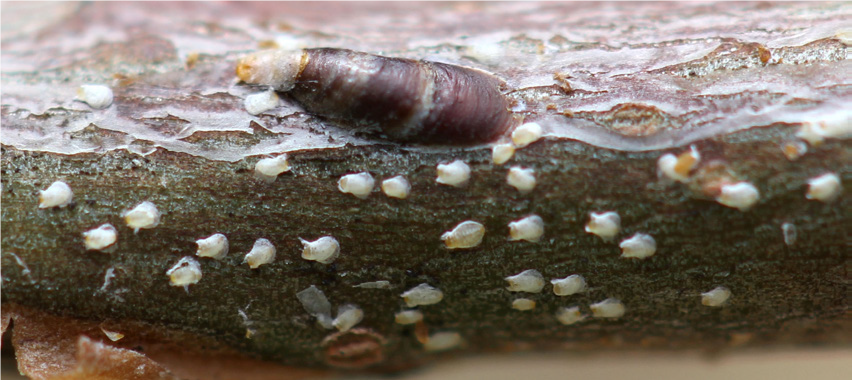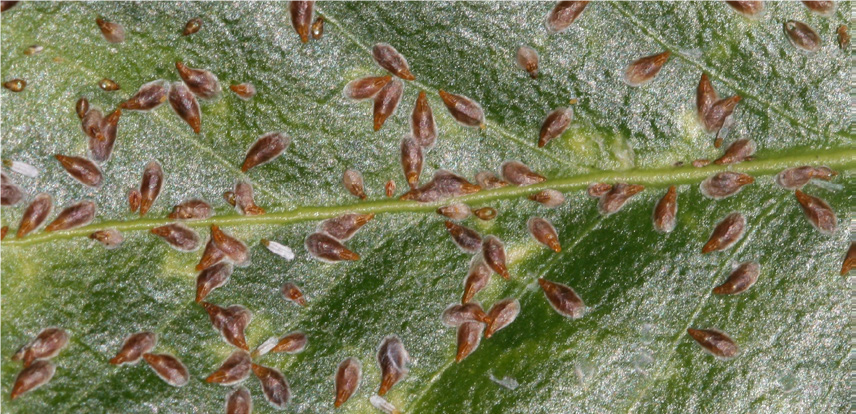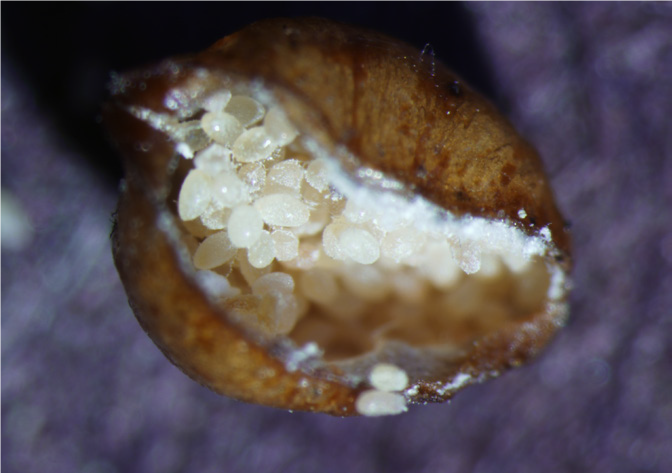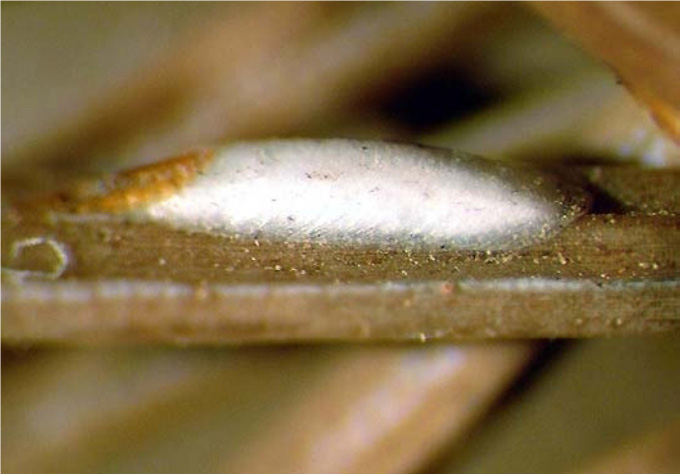In appearance, scales in general show little resemblance to typical insects. They are well protected by the waxy, almost impermeable shell they live under. The female lays eggs under this shell, which offers them protection. When the eggs hatch, the "crawler" stage is motile and will crawl about on the host plant to select a feeding site. It is during the crawler stage of development that scales are easily killed with insecticides.
Except for the males of some species, adult scales are permanently affixed to a position selected during the crawler stage. Scale infestations frequently go undetected until the infected plants are completely encrusted. Scales insert their needle-like mouth-parts into the host plants to withdraw sap. Scales also secrete a clear sticky substance called honeydew which coats objects below infested plants. Honeydew in turn supports the growth of a black fungus called sooty mold.
Scale insects vary in size, shape, color, host preference, and life cycle. The following species are common to New Hampshire trees and shrubs:

Colorado State University, Bugwood.org.
Oystershell Scale: Oystershell scales (Lepidosaphes ulmi) are brown and shaped like an oyster shell about 1/8" long. They are found on twigs of lilac, ash, redbud, dogwood, poplar, willow, horse chestnut, elm, beech, walnut, cotoneaster, apple, birch, pachysandra, and other species. They overwinter as white eggs under the scale coverings. The eggs hatch in May, around the same time lilac blooms begin to fade. They achieve maturity by August. There is one generation per year.
Euonymus Scale: Euonymus scale (Unaspis euonymi) is obvious as brownish encrustations of the stems and twigs, and whitish spotting of the leaves, mainly on the underside. The primary host is Euonymus, but it is also found on Pachysandra and Celastris (bittersweet). Females overwinter on stems and leaves. Young crawlers are produced in May or early June. A second generation occurs midsummer.

Colorado State University, Bugwood.org.
Fletcher Scale: The Fletcher scale (Parthenolecanium fletcheri) adult female is light yellowish-brown, almost globular, and about 1/8 to 13/64" in diameter. It commonly attacks Taxus, juniper, and arborvitae. Only the females overwinter. They lay their eggs in late May and the eggs hatch by early July. Foliage on the inner portions of heavily infested plants is often blackened by sooty mold growing on the honeydew excreted by the scales. There is one generation per year with crawlers appearing again.
Pine Needle Scale: The primary host of the pine needle scale (Chionaspis pinifoliae) is pine or spruce and occasionally Douglas fir and hemlock. The eggs of the pine needle scale overwinter under old female scales and hatch into crawlers in May. Females develop white scales about 1/10" long, while male scales measure about half that length. The pine needle scale reaches maturity by July. A second generation reaches maturity in fall.


cover. Credit: Bruce Watt, University of Maine, Bugwood.org.
Management
IPM Strategies:
- Sanitation - Eliminate all weeds within and around the greenhouse and remove plant debris and old stock plants from the greenhouse.
- Monitoring - Look for signs of scale presence, including: (1) scale and mealybug adult males on sticky cards, (2) ant activity on plants, (3) honeydew and sooty mold on the topside of leaves, and (4) especially on young leaves, look for distortion and discoloration resulting from feeding.
- Cultural Practices - Place screens on greenhouse openings, including side and ridge vents. Avoid planting susceptible cultivars.
- Biological Control - There are a number of commercially available natural enemies for some scales, such as ladybirds and parasitoid wasps. They may be helpful for plants grown indoors, but would do little good outdoors, where the agents could disperse.
- Chemical Control - Several insecticides are available for scale control. Make sure you select an insecticide that is registered for use on the crop you plan to use it on. Follow the label! All pesticides have the potential to damage sensitive crops. To be safe, apply to a few plants first. The key to scale control is early and frequent applications of pesticides before populations build up.
Consult your county Agricultural Field Specialist for specific pesticide recommendations.

Bugwood.org.

Stop! Read the label on every pesticide container each time before using the material. Pesticides must be applied only as directed on the label to be in compliance with the law. All pesticides listed in this publication are contingent upon continued registration. Contact the Division of Pesticide Control at (603) 271-3550 to check registration status. Dispose of empty containers safely, according to New Hampshire regulations.
Download the resource for the complete factsheet.

